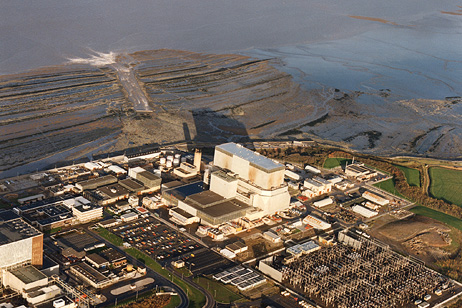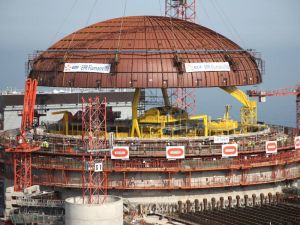
A meeting of French nuclear safety experts that took place this week has determined that there are still important safety questions to be resolved over the nuclear reactor at Flamanville.
The concerns centre on the steel reactor vessel at the heart of the reactor, which as it was revealed last year is metallurgically flawed owing to large areas of excess carbon in the steel causing structural weaknesses. Similar problems apply to the vessel head.
ASN, the French nuclear safety inspectorate, is now expected to follow the advice of the Permanent Group of Experts on Pressurised Nuclear Equipment (PGEPNE) and, within weeks, order another round of safety tests that could take until mid-2016 to complete.
The situation is causing acute concern at EDF, the French parastatal that owns the Flamanville project, and Areva, another French parastatal corporation whose subsidiary, Le Creusot, forged the reactor and its head using an inadequate casting process causing ‘carbon aggregation’ in the steel that makes it brittle and prone to cracking.
First it will only add to costs and delays at the reactor – which is already over six years late and more than three times over budget, and remains a long way from completion.
The Flamanville reactor was ordered in 2006 for a price of €3.3 billion and was meant to be generating power in 2012. According to a recent EDF statement, it is now scheduled for completion in the 4th quarter of 2018 and costs are assessed at €10.5 billion.
And even that estimate is “optimistic”, says Yves Marignac of the nuclear technology consultancy WISE Paris, who attended the PGEPNE meeting on Wednesday. “Really it was just catching up with reality, but there are still many, many problems to be oversome, including that of the reactor vessel which was not even mentioned in the completion schedule.”
The last thing EDF needs is yet another delay, additional cost and more uncertainty – and that’s exactly what it is getting. It also forces the company to make a very dangerous decision. Should it cut its losses, put contruction on hold, send its armies of workers home – and in the process lose critical momentum that will assure that its completion targets will be missed?
Or should it push ahead with construction at the site, and risk putting good money after bad in the event of the ‘nightmare’ possibility: that at the end of all the tests on the Flamanville reactor vessel, it will be found irremediably deficient and require total replacement.
In that scenario, says Marignac, the entire reactor project would almost certainly be abandoned: “It is really a question of life or death for the project.”
Why it could bring down the Hinkley C project
ASN’s decision will also impact on EDF’s Hinkley C project at a very critical time – indeed it could well sink the project altogether.
Chinese president Xi Jinping will be on an state visit to Britain this month from 20th to 23rd October during which EDF is relying on a complex multi-party deal being signed between itself, Xi Jinping, Chinese state nuclear companies and the UK government to fully finance Hinkley C’s construction, estimated to cost almost £25 billion.
EDF is hoping that the China General Nuclear Corp and China National Nuclear Corp will take a 40% stake in the project, proving capital essential to its construction owing to EDF’s liquidity gap and the reluctance of commercial investors to risk their money on the project.
But the continuing problems with the Flamanville reactor vessel could turn the Chinese off altogether – because Hinkley C is to use exactly the same EPR (European Pressurised Reactor) design as Flamanville, using two of the Le Creusot-forged pressure vessels.
The Chinese are also increasingly worried about their own two EPR reactors under construction at Taishan 1 and 2. Their reactor vessels and heads were also forged by Le Creusot and while test results have been released, they probably suffer from the same metallurgical defect of ‘carbon aggregation’.
If China is serious about nuclear safety, as France’s ASN clearly is, that will result in long delays and cost escalations as it has at Flamanville. In which case the last thing they will want is yet another failed EPR project on their hands.
But that’s not all – the UK’s finance guarantees are at risk
As part of its support package the UK has offered investors in bonds to finance Hinkley C construction £17 billion in finance guarantees – meaning that they will get their capital and interest paid no matter what, at British taxpayer expense, even if the Hinkley C project and its shareholders all go belly up.
The finance guarantees have been approved by the European Commission – but subject to a number of important conditions. These include a so-called ‘Base Case Condition’ (BCC) relating to the Flamanville EPR. Namely, that if the Flamanville reactor is not complete and operational by the end of 2020, the guarantees become invalid and bond holders must be repaid out of shareholder equity.
Under the deal, “if an event of default occurs, the parties have set-up two conditions (the Base Case Condition and the FFS Failure Condition) which allow for the Guarantor to require that the Base Equity is accelerated, or respectively, that the Contingent Equity is accelerated, i.e. immediately provided and applied to discharge the Bonds and the amounts due to the Guarantor.
The ‘FFS Failure Condition’ is secret but appears to relate to ‘fitness for service’ checks on the reactor pressure vessel and pressurised pipework. The requirement of the BCC is that “satisfactory evidence has been provided that Flamanville 3 has completed the trial operation period and that the requirements of the Guarantor in respect of performance during such period have been met.”
The UK government, as guarantor, has the option to extend the date for meeting the BCC (from where set in the guarantee contract) “by increasing the amount of Base Equity and procuring that such increase benefits from the required credit support” – meaning by forcing shareholders to provide additional credit guarantees. However this is subject to the stipulation: “The Base Case Condition date cannot fall later than 31 December 2020.”
As the Commision explains,
“This combination of provisions is intended to ensure that the Shareholders and not the Guarantor retain the principal exposure to the viability of the EPR technology until such time as there is objective evidence for confidence through the success of precedent projects such as Flamanville 3 and Taishan 1.”
Potential for years of additional delays
At the time all this was being agreed the idea that Flamanville might not be completed by the end of 2020 would have been regarded as the height of improbability. However it now looks increasingly probable.
The current date that EDF has set is the fourth quarter of 2018, which many might consider to be code for early 2019 at the soonest. Now the requirement to be imposed on EDF and Areva to carry out yet more tests on the Flamanville reactor vessel is certain to cause further delays, says Marignac.
“Results could come in the first half of 2016. If everything goes fine then we meet again in June 2016. At that time we will look at the results and there are three options: either its all OK, or it’s a complete failure, or – and this is the most probable outcome – somewhere in between: more tests, additional engineering works, and so on.
“I do not expect a final decision until late 2016 and if there are problems it could be further delayed. In fact it could remain unresolved until 2017, and there is a risk for Areva and EDF that it all drags on an on and there is still no conclusive result in three years time.
“The crucial reason is that the fabrication process went so wrong and produced such a high carbon concentration in parts of the metal that we do not even have engineering studies to determine its mechanical behaviour.”
Marignac also warns any prospective participant in Hinkley C that they are taking a big risk by taking part in a project with such reckless partners:
“Areva took a heavy risk by choosing an inadequate process. They got it very wrong in assessing the process in terms of the quality of the material and the carbon segregation. They know the risk existed and they went up to installing the vessel without any stop point.
Just as George Osborne is hoping to get China to invest billions in EDF’s Hinkley C nuclear plant in Somerset, news from EDF’s Flamanville nuclear site threatens to sink the project. French regulators are to demand another lengthy round of tests on its flawed reactor vessel. And if Flamanville isn’t working by 2020, £17 billion of UK finance guarantees for Hinkley C will collapse.
“EDF then took the project on knowing about the problem with the pressure vessel and invested billions in building the reactor around it. That is really really worrying. The first level of ‘defence in depth’ will remain degraded whatever happens.
“ASN warned on many occasions of the industrial risk they were taking of constructing the reactor around a vessel that was not technically qualified. Both Areva and EDF have taken this risk – that the vessel could be unacceptable in the end. That they find themselves in this position with such a key component of the reactor should make anyone very wary about partnering them them.”
Can Flamanville be completed by 2020?
The reactor vessel safety issue is by no means the only concern, adds Marignac: “You cannot imagine all the tests that need to be done before it can start can be done quickly. On the contrary because of the all the problems and time delays pipework will have rusted, joints will have lost their elasticity, and these problems will all have to detected and fixed.”
So what about the prospects for Flamanville’s completion by 2020? “It remains very open. It is still achievable but there are so many open questions and many problems are likely to be encountered before the reactor can be started up. It is very possible that they will not achieve this.”
These are hardly reassuring words for Xi Jinping and his Chinese nuclear companies as they consider whether to take on Hinkley C. With the very real possibility of Flamanville’s failure to complete by the end of 2020 and the consequent collapse of the UK’s finance guarantees, there’s suddenly another £17 billion at stake in a nuclear project whose wheels are already looking dangerously wobbly.
Is it all a risk too far? Let’s look at it this way. Would you sink your pension fund into Hinkley C?
source

More Stories
Navalny’s death used to hide western failures in Ukraine and their support for Israel’s genocide
Gifts from Gaza
Vulture capital circles over the corpse of Ukraine…